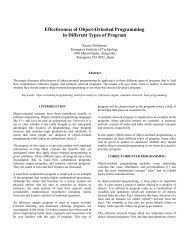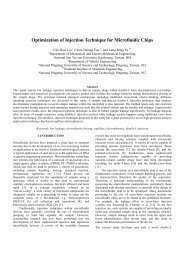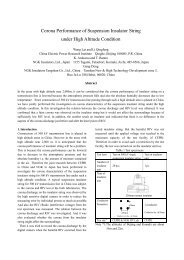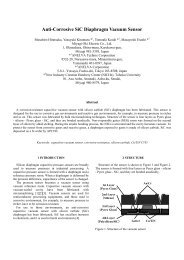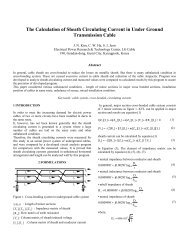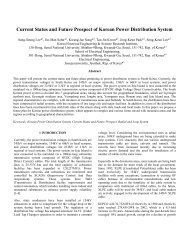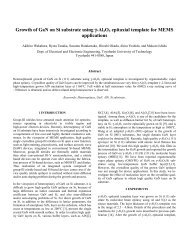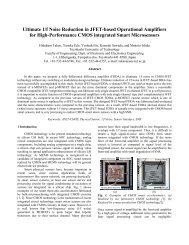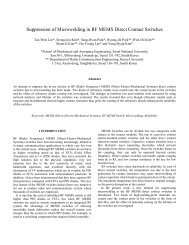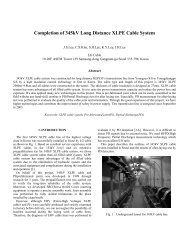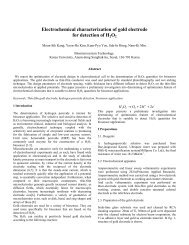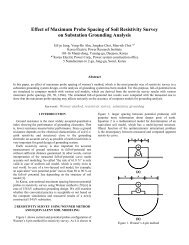Technology of Electroless Copper Plating for MEMS
Technology of Electroless Copper Plating for MEMS
Technology of Electroless Copper Plating for MEMS
Create successful ePaper yourself
Turn your PDF publications into a flip-book with our unique Google optimized e-Paper software.
<strong>Technology</strong> <strong>of</strong> <strong>Electroless</strong> <strong>Copper</strong> <strong>Plating</strong> <strong>for</strong> <strong>MEMS</strong>Yi Li, Xiang Han, Yilong Hao, Guizhen Yan, Wengang WuInstitute <strong>of</strong> Microelectronics, Peking University, Beijing 100871, ChinaAbstractSome newly-developed techniques <strong>of</strong> electroless copper plating <strong>for</strong> <strong>MEMS</strong> are reported in this paper. In order to make theelectrolessly-plated copper film adhere to the silicon surface perfectly, we propose using oxygen plasma bombardmentcombined with ion implantation and KOH etching to do physical treatment on silicon surface. The copper film’s thickness andsheet resistance are found 1500 angstroms and ڤ/0.14Ω (this datum is given by a four-point probe instrument), respectively,and the copper crystals <strong>of</strong> approximate 300 nanometers in diameter are fine and symmetrical. It is found that the copper can beselectively plated on silicon surface but not on the glass surface, and the silicon structures are encapsulated completely by thecopper film. So far the average thickness <strong>of</strong> the electrolessly-plated copper film has reached 3 microns since the newtechniques, such as oxygen-plasma-bombardment silicon surface treatment, are applied in the electroless copper plating.Key words: <strong>MEMS</strong>, electroless plating, oxygen plasma bombardment1 INTRODUCTIONThe technology <strong>of</strong> electroless plating different from theelectroplating , which is actually a kind <strong>of</strong> chemical platingwithout the introduction <strong>of</strong> electricity, is widely used inmany fields such as copper interconnects in print circuitboards. At the same time, this technology has been appliedin microelectronics and microelectromechical system. [1]First, the copper film can be plated on the surface <strong>of</strong> thepolysilicon. Second, this process can be realized on siliconwhich is the most widely used material in themicroelectronics. We have employed this process infabricating the micro-accelerators and micro-gyroscopes <strong>for</strong>its selectivity and con<strong>for</strong>mality. So the device’s parasiticresistor can be reduced, consequently the quality factor andper<strong>for</strong>mance can be improved. Because the parasitic resistor<strong>of</strong> passive devices is the main restricting factor, a thickercopper film is necessary in RF.The basic principle <strong>of</strong> the electroless copper plating is thatthe oxidation and reduction reactions are per<strong>for</strong>med on theactivated solid surface in the solution. The reducer reducesthe copper ion into copper film. Oxidation reaction:Cu 2+ + 2e - Cu (1)Reduction reaction:2HCHO + 4OH — 2HCOO - + 2 H 2 O + 2e - (2)Based on the theory <strong>of</strong> chemical thermodynamics, thereaction can take place only when the potential <strong>of</strong> thereducer is lower than that <strong>of</strong> the copper ion. In thealkalescence solution, <strong>for</strong>maldehyde can reduce the copperion. In order to keep the PH value <strong>of</strong> the solution in theproper range, it is necessary to add the potassium hydroxideinto the solution. In order to prevent the precipitation in thesolution, we should reduce the concentration <strong>of</strong> thedissociated copper ion and add the complexing agent intothe solution. The amount <strong>of</strong> the complexing agent should betaken into careful account. There are a lot <strong>of</strong> subsidiaryreactions in the solution. In order to prevent these reactions,it is necessary to add additives into the solution. In order toreduce the stress <strong>of</strong> the plated copper film and improve thequality <strong>of</strong> the copper film, it is necessary to add surfactantinto the solution. [2]The base material which can be plated with copper filmshould be activated by catalyst. Palladium chloride is themost widely used catalyst. It’s basic process is the <strong>for</strong>mation<strong>of</strong> catalytic center - palladium particulate, crystal element orcrystal layer.We have employed different treating methods and discussedthe improvement <strong>of</strong> silicon surface’ character and theinfluence on the plated layer due to these treating ways. Wefurther investigate the process condition <strong>of</strong> plating thickcopper film. This process indicates that the quality <strong>of</strong> thecopper film has close relationship with the silicon surface’scondition. Silicon as a semiconductor material is differentfrom the metal copper in the electrical and mechanicalcharacters. It is necessary to treat the silicon surface be<strong>for</strong>ethe plating. Besides the chemical activation to the siliconsurface using the palladium chloride, we should improve thesilicon surface’ physical aspect condition. On the other hand,the stress between the silicon and copper layer will influencethe quality <strong>of</strong> the thick copper film.2 THE PROCESS AND CONDITIONThe recipe <strong>of</strong> electroless plating copper consists <strong>of</strong> thefollowing components: activation solution: palladiumchloride (0.2g/L) and hydr<strong>of</strong>luoric acid (150ml/L);Oxidation agent: cupric salt <strong>of</strong> cupric sulfate (5g/L);reduction agent: <strong>for</strong>maldehyde; brightener:2,2’-dipyridyl(25ml/L); complexing agent: EDTA(15g/L);surfactant:RE-610(2.4mg/L). We also use the potassiumhydroxide to adjust the PH value. The plating temperature is60 0 C.[3]
The process steps are treating be<strong>for</strong>e the plating, activationand plating. We use the (100),heavily n-doped 4” wafer. Thetreating procedures include the improvement <strong>of</strong> thecleanness and enhancement <strong>of</strong> the coarseness <strong>of</strong> the siliconsurface. For the first aspect, we can use the nanostrip( amixture <strong>of</strong> sulfuric acid and hydrogen peroxide). But it iseasy to damage the metal electrode on the glass <strong>for</strong> thedevices are fabricated using the standard bulk siliconprocess .For the second aspect, besides the ion implantation(35KeV, 5E15, P + ), we also employ the oxygen plasmabombardment, so the quality <strong>of</strong> the plated layer can beimproved greatly. Activation is a process that stripping <strong>of</strong> thenative oxide layer and <strong>for</strong>mation the catalytic center-palladium particulate on the silicon surface. Generally, thelonger the activation time is, the more catalytic centers<strong>for</strong>med on the silicon surface. But considering thehydr<strong>of</strong>luoric acid’ eroding to the glass, the activation time iscontrolled in a minute. The devices are put into the strainermade by teflon in the plating solution.If we first use potassium hydroxide to erode the surface andthen employ ion implantation, the surface’ condition can beimproved. The silicon surface shown in the Fig. 2(a) istreated after these steps: eroding the surface by potassiumhydroxide, wiping <strong>of</strong>f potassium ion, ion implantation,activation and plating. The stress between the plating layerand silicon surface makes the plating layer bubble. Thecopper layer is not uni<strong>for</strong>m. When we increase the platingtime, the stress makes the bubble break and then can bereleased. This phenomenon is reflected in the Fig. 2(b). Theeroding to surface by potassium hydroxide reduces thecoarse degree <strong>of</strong> the surface, but at the same time producesthe adverse influence to the binding strength between platinglayer and base material.The basic experiment equipments are: microwave utensilcontaining the active solution (2 litres), glass beakercontaining the plating solution (3 litres), strainer, severalutensils containing DI water, thermometer, graduated flaskand scale.3 EXPERIMENT AND DISCUSSION3.1 Binding Strength between <strong>Plating</strong> Layer and BaseMaterialIn order to increase the binding strength between platinglayer and base material, we employ the ion implantation tomake the silicon surface coarse. There is meshwork on thesilicon surface shown in the Fig. 1. The silicon surface in themeshwork is implanted while the surface around themeshwork is not implanted. The plating layer <strong>for</strong>med in theion implantation area bubbles, while the plated layer <strong>for</strong>medaround the ion implantation does not bubble after the platingbecause it is difficult <strong>for</strong> the plated layer <strong>for</strong>med in the ionimplantation area to release the stress.(a)(b)Figure 2(a). The plated layer <strong>for</strong>med after eroding thesurface by potassium hydroxide, wiping <strong>of</strong>f potassium ion,ion implantation, activation and plating (a)10 minutes and(b)15 minutesFigure 1. The plated layer <strong>for</strong>med after ion implantation,activation and platingThis stress prevents the copper layer adhering to the siliconsurface tightly. So it is difficult to achieve the thick copperlayer. We employ the oxygen plasma bombardment to treatthe silicon surface when plating the thick copper layer.
The silicon surface shown in the Fig. 3 is treated after thesesteps: eroding the surface by potassium hydroxide, wiping<strong>of</strong>f potassium ion, ion implantation, removing the nativeoxide layer by hydr<strong>of</strong>luoric acid, oxygen plasmabombardment, activation and plating. When the silicon isdipped into the active solution, there are black flocculesfloating from the silicon surface. The copper film may beamorphous at first and then becomes large column crystalwhen the copper layer becomes thick. We investigate thepr<strong>of</strong>ile <strong>of</strong> copper layer in the Fig. 3(b). The copper crystal ismeticulous and the crystal particulates are symmetrical insize. The diameter <strong>of</strong> column crystal particulate is 300nm.The copper layer is smooth and bright. The thickness <strong>of</strong>copper layer is about 1500 angstroms and the squareresistance is 0.14Ω/□. When the plating time is increased,the stress between plated layer and base material makes thecopper layer bubble.(a)(b)Figure 3(a). The plated layer <strong>for</strong>med after eroding thesurface by potassium hydroxide, wiping <strong>of</strong>f potassium ion,ion implantation, removing the native oxide layer byhydr<strong>of</strong>luoric acid, oxygen plasma bombardment, activationand plating. (b) The pr<strong>of</strong>ile <strong>of</strong> copper layer shown in the (a)The copper layer adheres to the surface well and its qualitycan be improved greatly though eroding the surface bypotassium hydroxide, ion implantation and oxygen plasmabombardment.3.2 Investigation to Activation MechanismWhen the silicon is dipped into the active solution, there areblack floccules floating from the silicon surface. Becausethere only exist hydr<strong>of</strong>luoric acid (150ml/L) and palladiumchloride (0.2g/L) in the solution and metal palladium isblack, the black floccules should be metal palladium. Weonce put the silicon into tin (Π) chloride dehydrate solutionand then into palladium chloride solution, but the quality <strong>of</strong>copper layer is bad. This experiment indicates that theelectron provided by the tin (Π) chloride dehydrate canreduce the palladium ion, but it is not benefit to the quality<strong>of</strong> copper layer. So we can make a deduction that <strong>for</strong> thesilicon with the crystal orientation (100), there exists suchstructure (=SiH 2 ) after hydr<strong>of</strong>luoric acid strips <strong>of</strong> the siliconsurface’s native oxide layer. Not every silicon atom has thisstructure with the double hydrogen ternimation. Because <strong>of</strong>the metal ion adulterated and the ineluctable defect <strong>of</strong> crystallattice <strong>for</strong>med in the process <strong>of</strong> silicon fabrication, somesilicon ions on the surface have dangling bonds with thesingle electron <strong>for</strong>med in the process <strong>of</strong> covalent bondbreaking. Silicon surface has the character <strong>of</strong> minus charges.The catalytic reaction is:=SiH 2 +Pd 2+ =SiPd +2H + . (3)It is the silicon surface that provides palladium ion withelectrons.[ 4,5,6]In order to prove this deduction, we fill hydr<strong>of</strong>luoric acidand palladium chloride into two different containersrespectively. The silicon is dipped into the hydr<strong>of</strong>luoric acidand the native silicon oxide layer on the silicon surface canbe removed then it is activated in the palladium chloridesolution. The black floccules also are found floating fromthe silicon surface.The silicon surface shown in the Fig. 4 is treated after thesesteps: eroding the surface by potassium hydroxide, ionimplantation, stripping <strong>of</strong> the native oxide layer byhydr<strong>of</strong>luoric acid, activation and plating. The quality <strong>of</strong>copper layer is well in this experiment. Compared to theresult indicated in the Fig. 3, the crystal is not even enough.Because the removing <strong>of</strong> the native silicon oxide layer andthe <strong>for</strong>mation <strong>of</strong> palladium center take place closely, thequality <strong>of</strong> the copper layer is better than that shown in theFig. 3.
Figure 4. The plated layer <strong>for</strong>med after eroding the surfaceby potassium hydroxide, ion implantation, stripping <strong>of</strong> thenative oxide layer by hydr<strong>of</strong>luoric acid, activation andplating.3.3 Selectivity to the Base MaterialWe find that the copper layer cannot be plated on the surface<strong>of</strong> the glass, silicon nitride and silicon dioxide. It indicatesthat the selectivity to the base material in this experiment.The silicon surface is oxidized first and then a silicondioxide <strong>of</strong> 800 angstrom is <strong>for</strong>med. Silicon dioxide can beetched and then a meshwork is <strong>for</strong>med. So silicon is in themeshwork and silicon dioxide is around the meshwork. Wefirst bombard this silicon plate using oxygen plasma andthen put it into the active solution. It is found that the copperfilm cannot be plated on the surface <strong>of</strong> silicon dioxide. Weinvestigate the amplificatory results in the Fig 5(b), and findthat the boundary is very clear.(b)Figure 5 (a). The selectivity <strong>of</strong> this plating and (b)amplificatory results3.4 Exploring to the <strong>Plating</strong> Thick <strong>Copper</strong> LayerThe silicon surface shown in the Fig. 6 is treated after thesesteps: oxygen plasma bombardment, activation and plating.The thickness <strong>of</strong> the copper layer is about 5 microns. Thecopper layer bubbles and the coralloid crystal is <strong>for</strong>medbecause copper layer are very thick. So we conclude thatsilicon surface becomes coarser after oxygen plasmabombardment. The thick copper layer can be achieved easily,but its quality is not very good and the crystal is not regular.Figure 6. The plated layer <strong>for</strong>med after oxygen plasmabombardment, activation and plating3.5 Analysis on the <strong>Copper</strong> Layer plated on the Surface<strong>of</strong> Device’ Structure(a)The copper layer on the surface <strong>of</strong> micro-gyroscope isshown in the Fig. 7(a). The device is fabricated using thestandard bulk silicon process. The thickness <strong>of</strong> the structureis 60 microns. The distance between the comb and the glassis 4 microns. This kind <strong>of</strong> plating has good con<strong>for</strong>mality andthe copper film is also plated on the sidewalls. We furtherinvestigate the copper film in Fig. 7(c) and find that thecopper layer bubbles somewhere. This phenomenonindicates that quality <strong>of</strong> copper layer has close relationship
with the structure.Figure 7(a) The copper layer on the surface <strong>of</strong> devicestructure. (b) Con<strong>for</strong>mality. (c) <strong>Copper</strong> layer bubbles.4 CONCLUSIONS(a)The active solution consists <strong>of</strong> hydr<strong>of</strong>luoric acid andpalladium chloride in this experiment. The function <strong>of</strong>hydr<strong>of</strong>luoric acid is not only stripping <strong>of</strong> native oxide layeron the surface but making it coarse and with dangling bond.It is just this structure that reduces the palladium ion. So thepalladium atom deposits on the surface and then further<strong>for</strong>ms the crystal layer. When the silicon is dipped into theactive solution, there are black floccules floating from thesilicon surface. The surface <strong>of</strong> silicon has a layer <strong>of</strong> blacksubstance after activation. This substance should be metalpalladium. This phenomenon indicates that palladium ion isnot reduced in the plating solution, but in the active solution.We find out the condition that realizes the high-qualitythin copper layer shown in the Fig. 3. It is treated after thesesteps: eroding the surface by potassium hydroxide, wiping<strong>of</strong>f potassium ion, ion implantation, stripping <strong>of</strong> the nativeoxide layer by hydr<strong>of</strong>luoric acid, oxygen plasmabombardment, activation and plating. When the plating timeis increased, the stress between the silicon and plating layermake the copper layer bubble and even break.Only through the oxygen plasma bombardment thethick copper layer can be realized. But there are coralloidcrystals on the copper layer.This kind <strong>of</strong> plating has selectivity. We have foundthat the copper layer can not be plated on the glass, siliconnitride and silicon dioxide. This kind <strong>of</strong> plating will haveadvantage if it is used in the standard bulk silicon process.This kind <strong>of</strong> plating has the great con<strong>for</strong>mality whichis another advantage when compared to the electroplating.ACKNOWLEDGEMENTS(b)(c)This work is supported in part by the National NaturalScience Foundation <strong>of</strong> China under Grant No. 90307007.REFERENCE[1] H.Jiang, Y.wang, J.L.A.Yeh, and N. C. Tien, “Fabrication<strong>of</strong> high-per<strong>for</strong>mance on-chip suspended spiral inductors bymicromachining and electroless copper plating,” IEEE2000MTT-S Digest[2] Xiao Xia Jiang, The fundamentals and practice <strong>of</strong>electroless plating, National Defence Industry Press,2000[3] J.L.Andrew Yeh, Hongrui Jiang , Hercules P.Neves,“ <strong>Copper</strong>-Encapsulated Silicon Micromachined Structures,”JMMS ,9, 2000[4] TONG Hao and Wang Chun Ming, “Application Study<strong>of</strong> open circuit potential-time technology and atomic <strong>for</strong>cemicroscopy on Si(100)/solution interface in Ag electrolessdeposition,” Acta Chimica Sinica, 60, 2002[5] G.S.Higashi, Y.J.Chabal, G.W.Trucks, andKrishnanRaghavachari, “Ideal hydrogen termination <strong>of</strong> theSi(111) surface,” AT&T Bell Laboratories, Murray Hill,New Jersey 07974
[6] G.S.Higashi, R.S. Becker, Y.J. Chabal, and A.J.Becker,“Comparison <strong>of</strong> Si(111) surface prepared using aqueoussolutions <strong>of</strong> NH 4 F versus HF,” AT&T Bell Laboratories,Murray Hill, New Jersey 07974BiographiesYi Li ,Graduate student in the Peking UniversityEmail: liyi@ime.pku.edu.cnXiang Han, undergraduate in the Peking UniversityYilong Hao,Pr<strong>of</strong>essor in the Peking UniversityGuizhen Yan ,Pr<strong>of</strong>essor in the Peking UniversityWengang Wu, Pr<strong>of</strong>essor in the Peking UniversityEmail: wuwg@ime.pku.edu.cn



